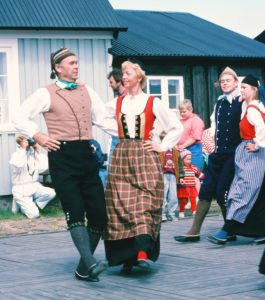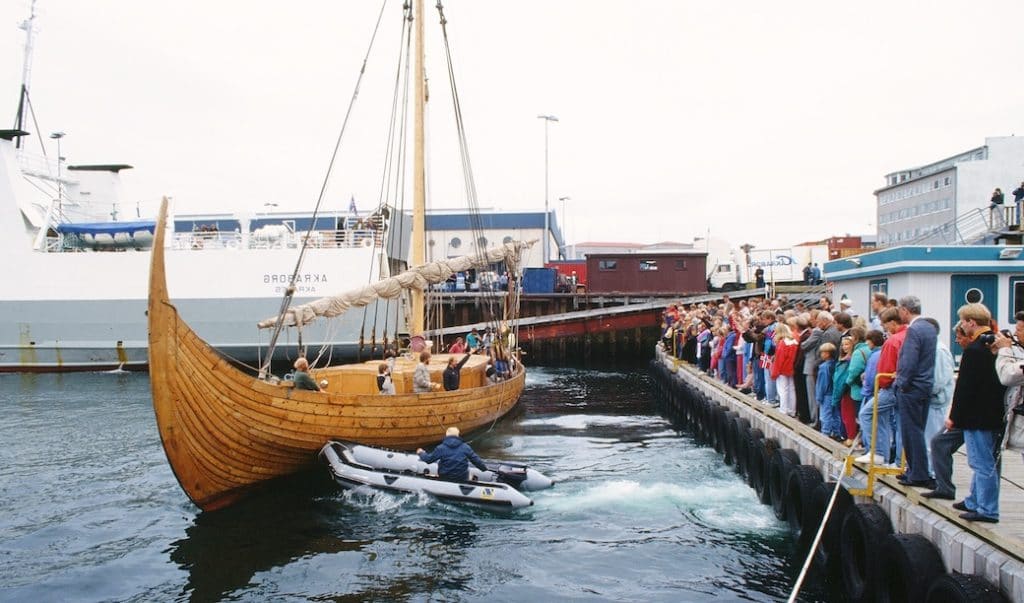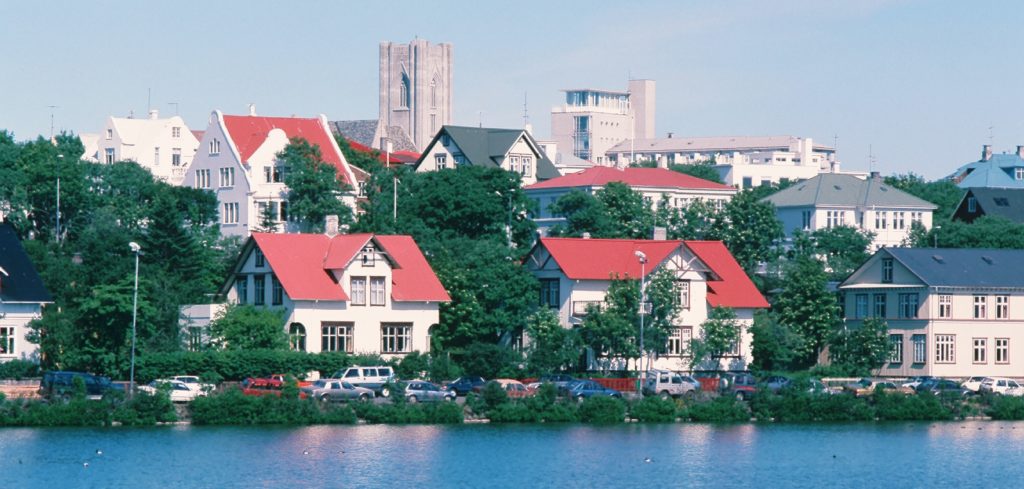It was a foggy June day in the year 793 A.D. when several longboats with dragon’s-head prows silently appeared out of the north. Pushed forward by billowing sails, the ships closed quickly on the island of Lindisfarne off the Northumbria coast. Each boat carried dozens of men, but from the moment they splashed ashore it was clear that these were no ordinary coastal raiders. The large scraggly warriors were Vikings and their target was a venerable Christian monastery full of golden chalices, silk tapestries and intricately carved triptychs.
Howling like wolves, the Vikings methodically set about the business of slaughter. Some monks were killed midway through their prayers. Others were felled trying to defend their hand-lettered vellum books. Those who failed to die quickly suffered “the blood eagle,” a terminal torture in which a man’s lungs were ripped from his chest and allowed to flap like crimson wings until the screams subsided. And then, just as quickly as they had come, the Vikings disappeared into the cold gray mist of the North Sea, taking with them the treasure and leaving behind a legacy of fear. For the next 300 years, nobles and clergy alike ended their nightly prayers with the whispered supplication: A furore Normannorum libra nos, Domine – “From the fury of the Northmen deliver us, Oh Lord.”
The pillage of Lindisfarne and other tales of Viking perfidy were fresh in my mind when I arrived at the harbor in Reykjavik on a brilliant summer afternoon. Bobbing gently next to the quay was the Gaia. This Norwegian pine replica of a ninth-century Viking ship was soon to sail for North America to commemorate Norsemen landing on the continent and remind Americans of their Viking heritage. But as the ship’s crew made ready to sail Captain Ragnar Thorseth confided that Scandinavians were the people who really needed the history lesson.
“Here people are still Vikings, but I despair of what’s happening in Norway,” Thorseth sighed, as he unlaced a canvas cover from the mainsail. “The most exciting experience in the world is to sail silently through a pack of icebergs. But in Norway everything is computers and high tech now.”
The 60-ft, single-masted Gaia itself hardly seemed to symbolize a great deal of Viking heritage. It certainly wasn’t menacing. As for the crew of ten, instead of sleeping in an open boat, they had cabins, a propane stove and an inboard motor for easier docking. Some Vikings!
I had turned away and was starting to leave when the Icelandic harbormaster arrived. Immediately, the atmosphere grew solemn as he ceremoniously placed a medallion around the neck of each crewmember. Lifting my telephoto lens I zoomed in for a close-up and discovered that those weren’t St. Christopher medals dangling from the chains. On the chest of each sailor rested a pagan amulet unchanged since the days of Eric the Red. It consisted of a bouquet of bludgeons. It’s name: the Hammer of Thor.

Solstice Dance Reyijavik Museum
Like a pendant on a necklace, Iceland, pop. 322,000, dangles from the Arctic Circle. Tiny, remote and forbidding, it is a land of fire and ice dominated by 250 active volcanoes, four enormous glaciers and a black pumice desert. The interior is a barren lifeless sprawl, riven with fissures that incessantly grumble and belch sulphurous spume. Iceland so closely resembles the surface of the moon that Apollo astronauts visited the country prior to their lunar landings. More recently it serves as the backdrop for scenes beyond The Wall in HBO’s Game of Thrones.
During the Middle Ages, Iceland was a place to be avoided. Europeans called Mt. Hekla, the “Abode of the Damned” and thought the doorway to Hell was located in its fiery innards. In 1783, the eruption of Mt. Lakagfgir was so powerful that it covered the entire continent of Europe with a blue haze. Novelist Jules Verne began his Journey to the Center of the Earth at the Snaefellsnes glacier north of Reykjavik. More recently, in April 2010, a volcanic ash cloud blanketed Europe for almost a week and caused the cancellation of more than 100,000 flights.
Iceland’s geological instability results from it location. The country rests atop the Mid-Atlantic Ridge, where the tectonic plates of Europe and North America rub together. As the two plates drift apart, fissures fill with molten magma and glacial water, which explode on contact to form geysers (an Icelandic words) and hot springs. The wonder of natural hot water means that Iceland can produce semitropical fruits and vegetables in greenhouses year-round. Thermal water heats most of Iceland’s homes, keeps pedestrian malls free of snow during winter blizzards and allows Reykjavik’s air, unpolluted by coal or heating oil, to remain the cleanest of any world capital.
Natural hot water also fills Reykjavik’s public swimming pools, which the city’s 205,000 people seem to visit on a weekly basis. In winter, bathers splash about in comfort while a crust of ice forms on their heads. In summer, they sit cheek-to-cheek in public hot tubs of varying temperatures, chatting amiably as they drink in the warmth.
I made it to a moderately hot pool and was rapidly turning the color of poached salmon when I was forced to admit that there is truth to the bromide that we are what we eat. Because their country produces little grain, and has barely enough pasture to sustain wandering herds of sheep, Icelanders are forced to live off the sea. Their diet of baked haddock and cod liver oil may not be tempting, but it clearly produces leaner physiques than high-calorie fare.
The Norse heritage lives on in diverse and profound ways. During the Viking epoch, women fought and died alongside men. Today, the country remains remarkably egalitarian. Just about everyone goes by his or her first name. Indeed, Iceland is such a first name country that telephone directories list subscribers in alphabetical order by their Christian names. When several people in the same city share a common name, professions are listed to distinguish one person from another.
“Our entire society is the same size as a small town in America, yet we have just as many brain surgeons, museum curators, artists and heart specialists as a large city,” says Vigdis Finnbogadóttir, Iceland’s 82-year old former president who today serves as a UNESCO goodwill ambassador. “We survive by spotting talent early and then providing enough financial support to ensure that it’s fully developed. The fewer fish that swim in a river, the more food they get,” she says with a smile.
Chief among the government’s priorities is preserving the Norse heritage. Children study Iceland’s sagas at every grade level. “The Viking reputation for violence was just a reflection of the age in which they lived,” explains Finnbogadóttir. “Vikings were traders, not terrorists.”
Perhaps. But though the Viking’s earthly demeanor may be subject to debate, their concept of the afterlife leaves no doubt about their spiritual orientation. Viking Heaven, Valhalla, was understood to be a great palace where fallen warriors fought all day for the fun of it. At the end of the day the dead and wounded were all healed so they could spend the night feasting on roast pork and mead. When the ale horns ran low, Amazonian Valkyries magically appeared with refills.
In modern Reykjavik the closest one can come to that sort of heaven is Astro, a long, squat disco on Laugavegur Street. Here from 10 p.m. to 4 a.m. every weekend, Iceland’s modern Vikings hone their predatory instincts while knocking back $12 shots of whisky. The action is even more intense at NASA, a super club close to theHotel Borg, where youths with cheeks the color of Mackintosh apples pass the evening in embrace. NASA attracts Kate Upton clones who, once lubricated on a potent schnapps called Black Death, are particularly expressive at interpretive dance. Yet, in a society where sexual mores are liberal, prostitution is almost unknown. There is no stigma associated with sex. With the age of consent at 15, Reykjavik may be the only world capital where an attractive woman of 32 might be a grandmother.
Where do these people get the energy? Would you believe whales. Iceland leads the world in the consumption of whale meat. Many of the fin whales (not an endangered species) caught by Icelandic trawlers end up at The Three Coats restaurant where chef Stefan Ulfarsson turns then into sashimi and pepper steak. “We Icelanders have been eating whale for more than 1,000 years,” says Ulfarsson. “As long as we manage our territorial waters prudently there is no justification for attacks by Greenpeace.”
Ulfarsson says Iceland rarely kills more than a dozen fin whales annually. “You’d think we were eating the California gray,” he fumes. “The numbers are infinitesimal. Do you know how many months it takes to eat a 40-ton whale?”
Whaling is an issue only because it is seen as an expression of cultural independence. For Iceland, survival depends on cultural purity, and no element of culture is more sacrosanct than its language. “Iceland is a poor country that never has had much timber or minerals or soil,” explains retired elementary school teacher Fjola Bender. “Our heritage is preserved in our language because words are all we’ve ever had.”
Unlike Danish, Norwegian and Swedish, which have evolved in a manner similar to English, the language spoken in Iceland has the same vocabulary and grammatical structure as that used a thousand years ago. The sagas students study each year are actual medieval texts. “Icelandic,” says Vigdis Finnbogadottir, “is the Latin of the Nordic tongue.” To preserve the purity of its language alternatives must be found for words incompatible with medieval Norse. Thus, words such as electricity, military tank and telephone translate as “amber power,” “creeping dragon” and “long thread.”
In a country where fire and ice are engaged in perpetual combat, inconsistencies are to be expected. When confronted by perplexed foreigners, Icelanders invariably recommend that they read the sagas. Those who do often end up even more confused.
Njall’s Saga, for example, is a 13th-century masterpiece describing the Viking defeat at the Battle of Clontarf in Ireland. It is read, discussed and in part committed to memory by every school child. It begins:
It is terrible now
To look around,
As a blood-red cloud
Darkens the sky.
The heavens are stained
With the blood of men,
As the Valkyries
Sing their song…
How could a people who are so devoted to studying and preserving their ancestral ties to the Vikings spirit have evolved into a society virtually free of crime and violence? The answer may be that by studying their sagas, Icelanders have learned the real lesson of their history.![]()
——–
David DeVoss is Editor and Senior Correspondent of the East-West News Service in Los Angeles



